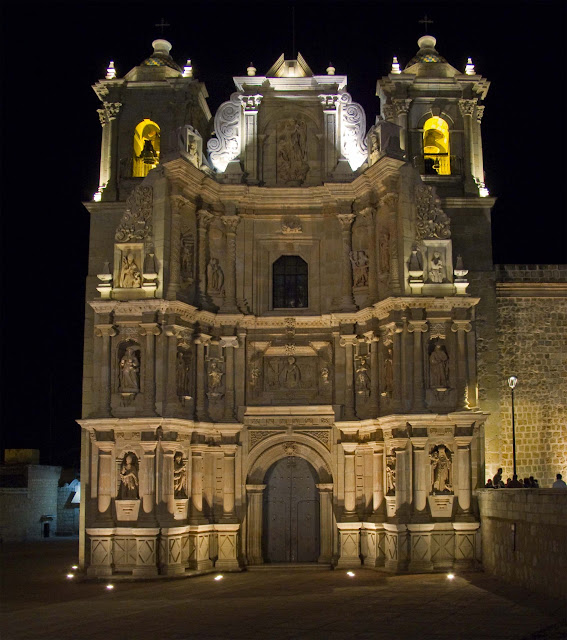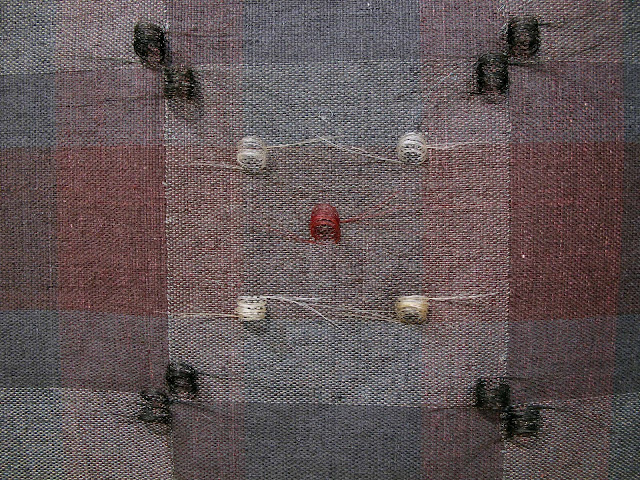 Built in 1529 by the Dominicans the convent of Santo
Domingo de Soriano, known as San Pablo, has emerged to become an
Academic and Cultural Center. The Foundation Alfredo Harp Helú Oaxaca (FAHHO)
undertook a comprehensive restoration of the former convent and rescued a
piece of Oaxacan heritage and provided the site
for the benefit of the community. The former convent of San Pablo is now a
cultural and academic center engaged in the study, teaching and dissemination
of indigenous cultures of Mesoamerica.
Built in 1529 by the Dominicans the convent of Santo
Domingo de Soriano, known as San Pablo, has emerged to become an
Academic and Cultural Center. The Foundation Alfredo Harp Helú Oaxaca (FAHHO)
undertook a comprehensive restoration of the former convent and rescued a
piece of Oaxacan heritage and provided the site
for the benefit of the community. The former convent of San Pablo is now a
cultural and academic center engaged in the study, teaching and dissemination
of indigenous cultures of Mesoamerica.


To understand what the architect Mauricio Rocha faced to
start the rescue of the former convent of Santo Domingo de Soriano, one must
consider the history of the property.
Since its founding in 1529, it has been altered by earthquakes, land for
sale in the eighteenth century, the nationalization of church property in 1860,
and during the 20th century housed a set of houses, shops, a hotel,
and parking garages. Before the restoration, two thorough investigations were
undertaken: both historical and archaeological, by Sebastian van Doesburg and
Gilberto Hernandez Diaz, respectively, which allowed the work of removal of
structures, and later directed the architectural intervention of Mauricio Rocha.
These investigations, as well as site restoration and adaptation, were
supervised and supported by the National Institute of Anthropology and History
(INAH). Each historical stage of
the property was visible in layers later construction overlaying the building’s
structure and the building was destroyed in some parts. The challenges for architectural
intervention arose from the removal of floors and walls that covered and overloaded
the structure of the building. The result of the measures taken during the last
five years by AHHFO consisted in the removal of floors, walls and slabs mainly
added during the twentieth century.

What was recovered was the former convent
with its courtyards, arcades, wall paintings, the chapel of the Rosary, the
choir and the choir loft.

In the process, archaeologists found the foundations
of a house, pottery and the remains of two human burials more than 2000 years
old. In addition as the result of the purchase of some neighboring houses, the
old alley that allows access to the original facade of the church and convent
became open to Independence Avenue. One of the hardest tasks was to reconcile
the different architectural languages on the site and to consider the new
cultural and academic uses.
Mauricio Rocha decided to use structures of metal and wood to create a
clean space. Rocha noted that the request of the president of the FAHHO, art
historian Maria Isabel Grañén Porrúa, was to design a cultural space, a
public-access library, and a school of Indian languages. "How could all
this fit in a project if it was left as a restored ruin? It was decided to make a contemporary
intervention, and I believe deeply that you can make a statement of this
century if it is done with deep respect and care." He respected the spirit of the
cloister: a building that includes a patio, a patio that has a window open to
the sky.

Based on the view that art and culture are intrinsically
linked to sustainable development, both economically and environmentally, the
former convent of San Pablo has been built considering catchment systems for
rainwater and photocells to harness solar energy. Rainwater from the roofs of the Academic and Cultural Center
San Pablo will be captured and stored in a cistern. The water collected will be
used to supply water for sanitation, cafeteria and landscape irrigation.
"What we have tried to define is a cultural and academic
center seat that can have different cultural and academic activities related to
indigenous cultures of Oaxaca and Mexico in general. Part of this is the
language, history, material culture, crafts, traditions ... but not seeing them
as separate elements of folk-tourist type. This will be a place that is
dedicated to reflect and understand the complexity and depth of Indian
heritage, which in Oaxaca felt everywhere, "says the historian Sebastian
van Doesburg.
The end the cultural center will build bridges of
understanding and work among Oaxacan indigenous communities and the country.
"It's about making those bridges.
Indigenous communities within the project have been marginalized
politically, economicly, socially and in cultural development. This has to do with an attitude of
ancestral social segregation and discrimination, and one of the elements that
we can do is to build bridges to overcome these divisions to better understand
the depth, creativity, dignity, the complexity of the native cultures of
Oaxaca."
 If your budget is tight try Cocina Economica Isabel a few
blocks further east just off Pino Suárez and just south of Parque Llano on
calle Cosijoeza #200. As they say don't judge a book by it's cover. The entry room serves tortas and nieves but walk back into the garden courtyard and there you
dine on your comida corrida in lovely surroundings. The food is simple but fresh and well prepared. The waitstaff is friendly and efficient. You start typically with a soup then
choose from five main plates, which rotate through the week. Like all comida
corridas it includes an agua fresca and a postre. Isabel is open Monday through Saturday.
If your budget is tight try Cocina Economica Isabel a few
blocks further east just off Pino Suárez and just south of Parque Llano on
calle Cosijoeza #200. As they say don't judge a book by it's cover. The entry room serves tortas and nieves but walk back into the garden courtyard and there you
dine on your comida corrida in lovely surroundings. The food is simple but fresh and well prepared. The waitstaff is friendly and efficient. You start typically with a soup then
choose from five main plates, which rotate through the week. Like all comida
corridas it includes an agua fresca and a postre. Isabel is open Monday through Saturday.




















































